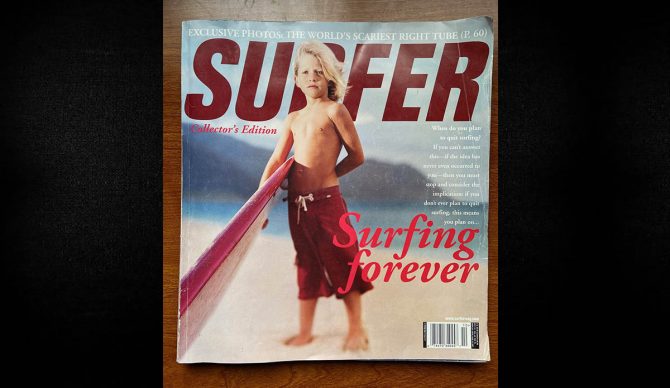
How do we know that we’ll surf forever? Photo: Sam George via SURFER
I’ve been surfing a long time. I’ve been writing about surfing for a long time, in a wide variety of mediums and formats: magazines, books, movies, websites…even advertising. Naturally, this level of ongoing involvement has resulted in a large body of work to look back on, which I do periodically, mostly to see if the perspectives expressed therein have retained their relevance. Which is, of course, another way of saying, “Did I get it right?” And believe me, having begun my written contribution to surf culture the same year as the thruster hit the scene, and continuing right up to last week, I’ve had plenty of opportunities to get it wrong.
Like when in the mid-80s, for example, I opined that having fully embraced tight, manhood-constricting boardshorts with three-inch inseams (see: Tom Carroll’s Quiksilvers), surfers would never go back to wearing long, loose baggies (see: Andy Irons’ Billabongs). Or when I flatly stated that adolescent John John Florence, raised free-range on the sand at Pipeline and showered with affirmation and free boards since age five, would never manifest the overarching drive for attention needed to win a world professional title. Talk about a swing and a miss. Yet this particular whiff relates rather directly to one of the occasions where I feel I got something very right. Appropriately enough, it involves a Florence.
Recently pulled from my archive is an annual “Big Issue” of SURFER magazine, published during my tenure as editor in October, 2001. The outsized ‘cover blurb’ I came up with stated its theme. “When do you plan to quit surfing?” it read. “If you can’t answer this — if the idea has never even occurred to you — then you must stop and consider the implication: if you don’t ever plan to quit surfing, this means you plan on…Surfing Forever.” And to really punch this point home, the accompanying cover photo, shot by the legendary Art Brewer, was an arresting portrait of six-year-old Nathan Florence.
When it comes to enduring relevance, I believe my brief profile of Nathan, featured as part of that cover story, is worth a reprint here.
“Can you be born a surfer? Six-year-old Nathan Florence is making a good case for the affirmative. Here is a young being, shaped and formed and nurtured by Blake’s ‘Blessed Church of the Open Sky,’ the prototypical surfer by definition. Nathan, the middle brother of a trio that includes younger Ivan and John John the elder, born and raised on the North Shore — born and raised by the North Shore. Living with his single mom, he has literally been reared by other members of the pack. His role models are myriad; all forged on the same sandy anvil, older versions of himself. Yet his young mother quietly explains that Nathan has already developed his own sense of style. Prefers single-fin longboards (has his own, red), not too many stickers, paddles out and gets waves by himself. And, like any six-year-old, he loves the fun, but like every surfer, is very serious about it. So here, now, at the beginning of his ride, with all of it stretching out ahead of him, Nathan is the surfer we all want to be — the surfer we all want to believe lives in each of us. Not separating who he is from what he does. Not questioning why or how or for how long. Just breathing it.”
To be honest, there was nothing arbitrary about digging out that dog-eared, back issue of SURFER, published almost a quarter of a century ago. I had just been watching one of Nathan’s recent video clips, in which, much like his six-year-old self, he was still riding a red board. It was the red board that triggered the look back. And what really got me, after re-reading my description of young Nathan, was how thoroughly he earned that cover shot, and has continued to ever since. Not necessarily for his successful surfing career and well-documented, hair-raising exploits, though impressive enough, but in how he so perfectly personified the theme of that special issue, summed up in the last words of my introductory essay, referring to another Brewer portrait juxtaposing six-year-old Nathan with 82-year-old surf culture pioneer John Kelly:
“And so, the grommet is just a younger version of an older surfer — the old surfer merely a grommet grown up. Surfers defy demographics because no real difference separates them, no lines of demarcation, only regular stages of development. Predictable, comforting stages that reassure us with their continuity. The grom looks at the graybeard and knows, ‘That will be me someday.’ The older surfer looks at the boy and knows, ‘He still lives inside me.’ This is the surfer’s life, each step, every phase, measured in varying degrees of passion. But never-ending. Because in continually moving toward that ephemeral moment — being there to meet that next breaking wave — the surfer, whether six or 82, discovers that the ride really does last forever.”
A bit overwrought? Perhaps. But in pointing to someone like Nathan Florence, back then and today, as an example, I like to think that in this particular case, I got it right.

